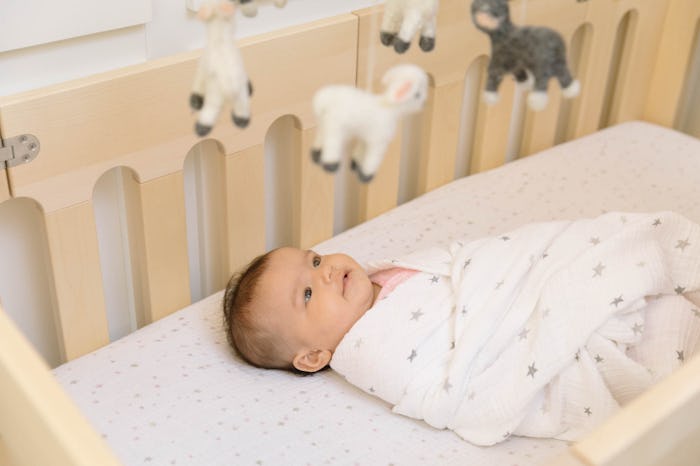Life
Is It Safe For Your Crib To Be Near A Window? Placement Is Key
When you're setting up your baby's room, it's exciting to choose paint colors, snag the perfect rocking chair at a garage sale, and line bookshelves with your childhood favorites. But between tamper-resistant outlets, securing furniture to the walls, and stowing away loose cords, there are also some safety measures to keep in mind. The same goes for the crib. You probably know the basics, like keep things minimalistic, but what about positioning? Is it safe for your crib to be near a window?
"Always set up your crib away from windows, blinds, and shelves," says Sage Singleton, a home and family safety expert from SafeWise, in an email with Romper. "This will ensure your child does not strangle himself/herself on window cords and that shelves do not fall on your baby. Also, it's best to keep the crib away from windows as babies or toddlers could potentially fall through the glass."
Singleton stresses that because kids spend the first two years of their lives sleeping in a crib, it’s essential to buy a crib certified by the United States Consumer Product Safety Commission (CPSC). This will ensure cribs meet the required safety standards. She recommends checking that a travel crib also has the same certification.
As for setting up the crib, be sure to follow the instruction manual, Singleton says. Even though you might be tempted to wing it, "reading the instructions and double checking your work will ensure your baby is safe while sleeping in the crib. Be sure to also check for jagged edges, loose bolts, or any other defects before placing your child in the crib."
Thankfully, when you are choosing a crib, you can rely on the CPSC’s pretty strict standards for both manufacturers and retailers. According to What To Expect, these requirements include stronger mattress supports and crib slats, durable crib hardware, and rigorous safety testing.
If you are traveling, then Singleton says it’s important to know the difference between a portable and travel crib, the former usually being made of wood or other hard materials that can fold up easily, and the latter being a completely collapsible crib made of soft material like foam or mesh.
The same rules, of course, apply with on-the-go crib setup as they do with your everyday crib — choose a safe spot for the crib, read the instruction manual, and follow crib safety rules, like avoiding excess clothing and keeping cushy stuffed animals out of the crib.
As for getting your baby to sleep in that crib? Well, that's another story.
